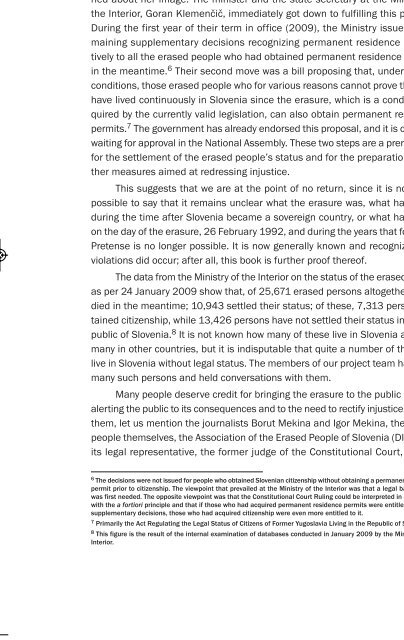The Scars of the Erasure_web
The Scars of the Erasure_web
The Scars of the Erasure_web
- No tags were found...
You also want an ePaper? Increase the reach of your titles
YUMPU automatically turns print PDFs into web optimized ePapers that Google loves.
<strong>Erasure</strong>_4a 10.1.11 20:29 Page 11THE ERASED PEOPLE YESTERDAY, TODAY AND TOMORROW11<strong>the</strong> settlement <strong>of</strong> this issue. Almost 79 percent <strong>of</strong> respondents agreed with <strong>the</strong>issuing <strong>of</strong> <strong>the</strong> remaining decisions to <strong>the</strong> erased people. This indicates thatMini ster Kresal, who vowed that “this sad chapter in Slovenian history will beconcluded once and for all, even if my ratings drop to zero,” should not be worriedabout her image. <strong>The</strong> minister and <strong>the</strong> state secretary at <strong>the</strong> Ministry <strong>of</strong><strong>the</strong> Interior, Goran Klemenčič, immediately got down to fulfilling this promise.During <strong>the</strong> first year <strong>of</strong> <strong>the</strong>ir term in <strong>of</strong>fice (2009), <strong>the</strong> Ministry issued all remainingsupplementary decisions recognizing permanent residence retroactivelyto all <strong>the</strong> erased people who had obtained permanent residence permitsin <strong>the</strong> meantime. 6 <strong>The</strong>ir second move was a bill proposing that, under certainconditions, those erased people who for various reasons cannot prove that <strong>the</strong>yhave lived continuously in Slovenia since <strong>the</strong> erasure, which is a condition requiredby <strong>the</strong> currently valid legislation, can also obtain permanent residencepermits. 7 <strong>The</strong> government has already endorsed this proposal, and it is currentlywaiting for approval in <strong>the</strong> National Assembly. <strong>The</strong>se two steps are a prerequisitefor <strong>the</strong> settlement <strong>of</strong> <strong>the</strong> erased people’s status and for <strong>the</strong> preparation <strong>of</strong> fur<strong>the</strong>rmeasures aimed at redressing injustice.This suggests that we are at <strong>the</strong> point <strong>of</strong> no return, since it is no longerpossible to say that it remains unclear what <strong>the</strong> erasure was, what happenedduring <strong>the</strong> time after Slovenia became a sovereign country, or what happenedon <strong>the</strong> day <strong>of</strong> <strong>the</strong> erasure, 26 February 1992, and during <strong>the</strong> years that followed.Pretense is no longer possible. It is now generally known and recognized thatvio lations did occur; after all, this book is fur<strong>the</strong>r pro<strong>of</strong> <strong>the</strong>re<strong>of</strong>.<strong>The</strong> data from <strong>the</strong> Ministry <strong>of</strong> <strong>the</strong> Interior on <strong>the</strong> status <strong>of</strong> <strong>the</strong> erased peopleas per 24 January 2009 show that, <strong>of</strong> 25,671 erased persons altoge<strong>the</strong>r, 1302died in <strong>the</strong> meantime; 10,943 settled <strong>the</strong>ir status; <strong>of</strong> <strong>the</strong>se, 7,313 persons obtainedcitizenship, while 13,426 persons have not settled <strong>the</strong>ir status in <strong>the</strong> Republic<strong>of</strong> Slovenia. 8 It is not known how many <strong>of</strong> <strong>the</strong>se live in Slovenia and howmany in o<strong>the</strong>r countries, but it is indisputable that quite a number <strong>of</strong> <strong>the</strong>m stilllive in Slovenia without legal status. <strong>The</strong> members <strong>of</strong> our project team have metmany such persons and held conversations with <strong>the</strong>m.Many people deserve credit for bringing <strong>the</strong> erasure to <strong>the</strong> public eye andalerting <strong>the</strong> public to its consequences and to <strong>the</strong> need to rectify injustice. Among<strong>the</strong>m, let us mention <strong>the</strong> journalists Borut Mekina and Igor Mekina, <strong>the</strong> erasedpeople <strong>the</strong>mselves, <strong>the</strong> Association <strong>of</strong> <strong>the</strong> Erased People <strong>of</strong> Slovenia (DIPS) andits legal representative, <strong>the</strong> former judge <strong>of</strong> <strong>the</strong> Constitutional Court, Matevž6 <strong>The</strong> decisions were not issued for people who obtained Slovenian citizenship without obtaining a permanent residencepermit prior to citizenship. <strong>The</strong> viewpoint that prevailed at <strong>the</strong> Ministry <strong>of</strong> <strong>the</strong> Interior was that a legal basis for thiswas first needed. <strong>The</strong> opposite viewpoint was that <strong>the</strong> Constitutional Court Ruling could be interpreted in accordancewith <strong>the</strong> a fortiori principle and that if those who had acquired permanent residence permits were entitled to receivesupplementary decisions, those who had acquired citizenship were even more entitled to it.7 Primarily <strong>the</strong> Act Regulating <strong>the</strong> Legal Status <strong>of</strong> Citizens <strong>of</strong> Former Yugoslavia Living in <strong>the</strong> Republic <strong>of</strong> Slovenia.8 This figure is <strong>the</strong> result <strong>of</strong> <strong>the</strong> internal examination <strong>of</strong> databases conducted in January 2009 by <strong>the</strong> Ministry <strong>of</strong> <strong>the</strong>Interior.


